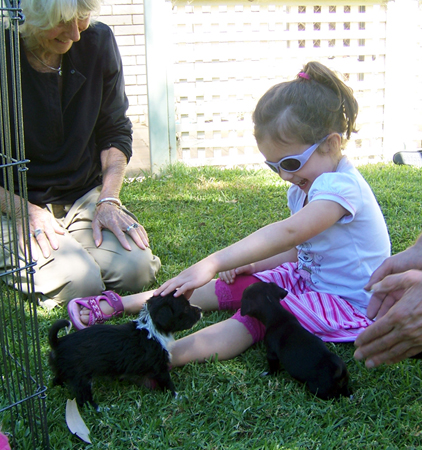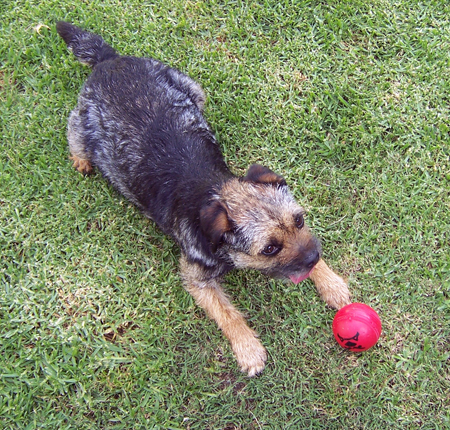This post is part of the series in response to Dunbar’s 2012 Australian seminars. See index.
Dunbar is big on socialisation, and thinks that breeders should put a lot of effort and attention to socialising their puppies. While breeders will select the best genetic combination, socialisation and training will seek to fix any deficiencies in the genetic package. He thinks many breeders are ‘not doing their job’ and are producing ‘lemon’ puppies. Good breeders, through socialisation, produce puppies that like being handled and like all people.
Puppy buyers need to know that all breeders are not created equal, even if producing pedigree dogs. A pedigree is not a socialisation history, and (to Dunbar) a socialisation history is more important than their pedigree.
Breeders are responsible for training puppies until they are 8 weeks old. They should be selling well-socialised, housetrained, and chew-toy trained puppies. (And if they are, they can charge twice as much for one – Dunbar’s motivator to breeders!) By 8 weeks, the critical period is half over! So breeders really need to be doing something.
A puppy that is exhibiting fearful behaviour at 8 weeks or earlier is problematic. At 8 weeks, a puppy should run up to all people – men, women, and children.
Before birth

It’s important for puppies to meet many different people before 8 weeks. These puppies are meeting this young girl and learning to be happy and confident in her presence.
Dunbar stressed not to read into this too much, but suggested that mothers be kept active before birth. It is possible that puppies may begin to learn tolerance by being bumped around in utero. (He did not suggest that bitches be palpated or manipulated, but just encouraged to live actively.)
Neonatals
When puppies are just born, they can smell and feel. This means that they can begin to build tolerance (or perhaps habituation) to touch. Dunbar believes this is particularly important for breeds known to dislike touch or be fearful – such as spitz breeds, herding breeds, and toys.
100 People before 8 Weeks
In their first 8 weeks of life, a puppy should meet 100 people. (The puppy buyer should then follow up by getting 100 people to meet in their new home in the first month.) The breeder should throw frequent ‘puppy parties’ (and encourage costumes) and otherwise get people into the kennel in whatever way possible. Parvo is not a huge risk, and risk can pretty much be obviated by asking visitors to remove their shoes.
Predicting and Preventing Behaviours
Socialisation and training should be based around preventing predictable behaviour problems.
Toilet training is a frequent problem. Breeders should be maximizing a puppy’s natural desire to toilet away from their bed. At 3.5 weeks, puppies will naturally try to get as far from their bed as possible. At 4 weeks, these puppies habitually go to the toilet area. If puppies are not given the opportunity to live away from their waste, they will learn to live in it. Toilet training can start by setting up a long term confinement area.
To make sure puppy buyers are keeping up on socialising, they can be invited back monthly for socialization parties.
Dunbar also mentioned that puppies should begin learning basic commands (come, sit, down, and roll over) with the breeder.
Further reading: Can breeders breed better?


Two points I found pretty interesting in your discussion was
“Parvo is not a huge risk, and risk can pretty much be obviated by asking visitors to remove their shoes.” – This is quite a big deal. I did not know that by simply removing one’s shoes, the risk for Parvo is reduced.
Next, I love the 100 people in 8 weeks rule. How’s Clover, by the way? When is she due?
Huggies and Cheese,
Haopee
Parvo is mostly spread by infected dog’s faeces, so removing shoes pretty much removes the likelihood of transfer. Unless, you know, your friends enjoy playing with parvo poo…
That picture is before Clover’s 2010 litter. She has had another litter since then, and we’re going to tracking training today. 🙂
Pingback: A Puppy Announcement | Some Thoughts About Dogs